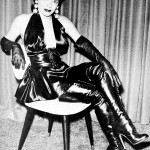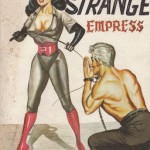Dennis, Donna. Licentious Gotham Harvard University Press, 2009 Amazon
As I’ve observed previously, there’s a lot of historical coverage of the European/British history of pornography, but not so much of American porn, at least in the 19th or early 20th centuries.
Dennis’ book bears this out, saying that while there was plenty of porn produced in antebellum New York, it was largely pirated editions of English or translated European works, notably John Cleland’s Fanny Hill (1748), easily the most popular, and Laurence Sterne’s Sentimental Journey (1768, published in New York as early as 1795). Little if any was actually written by Americans, at least until during and after the Civil War, when demand grew greatly. (Illustrations may have been created domestically, though the text isn’t clear.)
There’s also the problem that while a lot of pornographic material was produced, a lot of it was destroyed by Anthony Comstock and other moral reformers. Actually very little has survived in libraries or collections. Some volumes are lost to history and only known by titles in catalogues and perhaps a few excerpts published in legal proceedings.
It’s interesting to note that female pleasure and sexual experience were foregrounded in a lot of erotic works, which probably speaks mainly to male curiosity about female sexuality (cf. Les Bijoux Indiscretes), but it does suggest a certain interest in and perhaps fear of female sexuality.
[Akarman’s subscription-only magazine, launched 1856] Venus’ Miscellany offered a thrill of transgression by focusing on precisely the representations that years of New York obscenity prosecutions had singled out as the most illicit: expressions by women of sexual passion and pleasure. To intensify the sense of taboo, Akarman chose to highlight the carnal desire of seemingly “average,” middle-class women. To this end, he included a regular column of letters to the editor from purported subscribers, in which he showcased married women who wished to share their sexual experiences with readers. The writers recounted the excitement that subscribing to Venus’ Miscellany had added to their marriage, their enthusiastic erotic adventures with female neighbors, and their involvement in menages a trois in which their husbands passively followed their lead.
Pg. 7
Previously I thought the erotic letters style and format had originated in the British publication Englishwoman’s Domestic Magazine in the late 1870s, but it turns out Akarman was using it in America in the 1850s.
A related issue is the content of American pornography, particularly the sadomasochistic content. While Ian Gibson’s The English Vice has plenty to say about the role of corporal punishment in British society, he didn’t discuss American culture. Was there the Eton style of discipline in American schools?
According to Dennis:
The title’s reference to flagellation is noteworthy because explicit literature on whipping and sadomasochism rarely appeared in obscenity indictments in antebellum New York or in the catalogues of New York’s leading erotica dealers, even though it was quite popular in English pornography circles of the day. The relative rarity of such books in the New York market may mean that corporal punishment had less resonance as an erotic motif for consumers in New York than in England. In any event, the excerpt chosen by the district attorney, copied out in meticulously neat handwriting, did not touch on flagellation. Instead, it graphically described a sexual encounter between a young man, a girl, and an older woman, including the woman’s “longing” to engage in fellatio.
(Pg.100-101)
This is an interesting cultural question, one I’m not certain I know how to answer. As established, lots of British pornographic works were pirated across the Atlantic (including key kinky texts like Memoirs of a Woman of Pleasure and The Lustful Turk), but apparently they didn’t take as many of the flagellant ones. Did flagellation just have less appeal to Americans than it did to British? Did that change at some point?
It did exist. An 1850 case against a vendor of erotic prints included prints depicting “four androgynous figures, entirely naked except for their knee high stockings, have sex while flagellating and masturbating one another” and “a fancily dressed woman whips a man who is bound to a sumptuous divan, his pants drawn down to his knees to expose his bare buttocks to her lash.” [Pg.138]
The history of porn in America requires that we look at genres of media that aren’t generally considered porn, such as the captivity narratives, the related convent captivity narratives (to be discussed soon) and the previously discussed slavery narratives.
For instance, not only did you have non-pornographic works that could be read as pornography (e.g. captivity narratives and related genres), there were dour, anti-erotic treatises on the perils of female masturbation marketed as vehicles for sexual stimulation (e.g. The Secret Habits of the Female Sex, cited on pg. 105), and there were pornographic works passing themselves off as moral reform directories. Prostitution Exposed; or, A moral Reform Directory, Laying Bare the Lives, Histories, Residences, Seductions &c. of the Most Celebrated Courtezans and Ladies of Pleasure of the City of New York (published 1839, anonymous (“A Butt Ender”)) was a mockery of anti-prostitution campaign literature that catalogued sex work in the city, from streetwalkers to courtesans. (Pg.22-26)
Then there were works that did not come under the censor’s scrutiny. Flash crime papers, drawing on the traditions of city mysteries novels (which were both an European and American genre) and British penny dreadfuls. In American works of the 1840s and 1850s, we can already see the American preference for violence over sex.
The American version, often called yellow-jacket literature, recounted “tales of criminal underworlds, urban squalor, and elite luxury and decadence.” […] The most risque examples also specialized in horrifically detailed depictions of violence and torture, combined with euphemistic, titillating references to sexual license. The erotic scenes, while elliptical in their descriptions, nonetheless raised highly provocative themes. The sexual practices alluded to in sensational fiction included “incest, sadomasochism, homosexuality, group sex, miscegenation, child sex, [and] mass orgies.” Because of its obsession with the dark secrets and sexual excesses of life in the big city, this literature has appropriately been described as “American porno-gothic.”
Significantly, the leading publishers of American porno-gothic novels were often the very same men who published the expensive fancy books that typically provoked prosecution for obscenity. Frequently using a separate imprint to distinguish the genres, they typically marketed this relatively safe category of indecent literature as “racy” reading.
Pg. 108-109
[George] Thompson opened his 1850 novel Jack Harold with an evocative description of rampant sexual license in Gotham. New York was a “mighty metropolis that lies brooding upon the waters like a slumbering giant; in commerce, a monster–in vice, a hell–in splendor, almost equal to the fabled Oriental cities of the East–and in licentiousness, a rival of gay, voluptuous Paris.”
Pg. 110
Note Thompson’s use of Orientalism to describe his own city, figuring it as a similar zone of sexual anarchy.
Characters in his novels experience brutal whippings, violent rapes, disfigurement by acid, cannibalism, and other forms of torture, presented in chillingly graphic detail.
In sharp contrast to the expansive attention that he lavished on acts of violence and horror, Thompson wrote coyly and allusively about sex, substituting naughty winks to the reader for his otherwise ample powers of observation.
Pg. 111
The preoccupation of mid-nineteenth-century American sensational fiction with sexual transgression, violence, and crime often led reformers to condemn it as immoral and dangerous.
Pg. 111
Indeed, Karen Halttunen has argued that the sadomasochistic tendencies of American popular fiction arose precisely because middle-class reformers, such as antislavery advocates, were developing new humanitarian sensibilities that made representation of pain immoral and revolting. In this sense, the grotesque violence featured in race novels flew in the face of all that bourgeois moral reformers were trying to achieve.
Pg. 329 (end note to above)
And yet, all of this “porno-gothic” (the prototypes of our own era’s torture porn) sailed past all the legal authorities. According to David Reynolds’s Beneath the American Renaissance (a book my local library says they have but can’t find), this is all about Puritan guilt in the American collective psyche. (Dennis instead attributes this to strategic decisions by publishers, but that still doesn’t explain why sex is censored far more than violence.) This books were derived stylistically from European and British books, so they inherited certain tendencies.
At the same time, the omissions helped fetishize the perceived boundary between the obscene and the nonobscene, as evidenced by the prolonged leering at partially clothed women, exposed cleavages, and the like, that runs throughout his [Thompson’s] work.
[Pg.115]
At other times, sensational novels pushed beyond the limits of the flash weeklies, often thematizing subjects like incest, sadomasochism, and mass orgies, which were understood as far more transgressive than prostitution. While skirting around the description of actual sexual acts, racy novels nevertheless reflected sexual possibilities at least as provocative as those described in the books that prosecutors typically regarded as obscene.
[Pg. 117]
Yet another sector of porn publishing was upscale works that bore the patina of scientific study or high art instead of muckraking journalism. This included a lot of flagellant material, particularly the wares of J.W. Bouton, who published allegedly ethnographic treatises on flagellation, such as Exhibition of Female Flagellants in the Modest & Incontinent World and a seven-volume collection of “Rare Tracts on Flagellation” for $35, plus Mirabeau, Swinburne and even Sade.
So, the American pornographic tradition emerges from a distinct set of circumstances. The BDSM aspects that came from the city mysteries novels and the “porno-gothic” traditions is distinct from the European traditions, and not generally considered pornographic.




Sorry, the comment form is closed at this time.